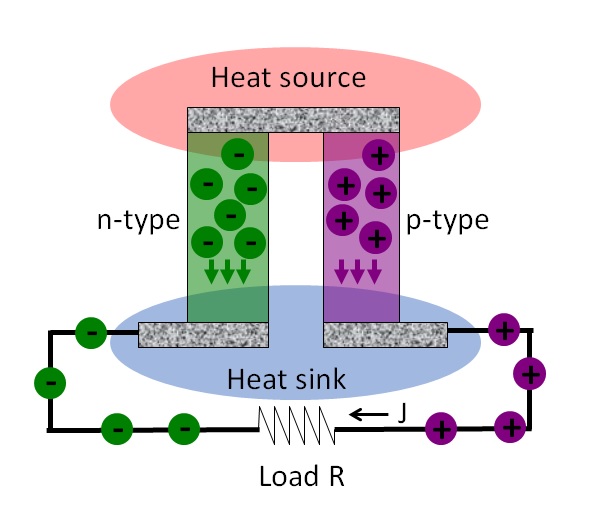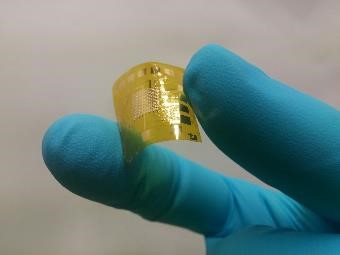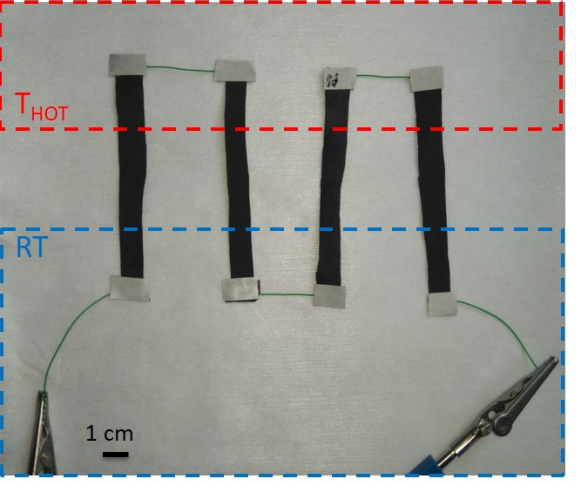The thermoelectric effect enables sustainable energy harvesting by converting heat flux into electric power, through the so-called Seebeck effect. Recently, doped conjugated organic semiconductors materials attracted great interests as suitable candidates to replace rigid, expensive and toxic inorganic materials used in currently commercial thermoelectric devices, thus enabling high-throughput in large scale realization of low-cost thermoelectric generators for low-power energy harvesting applications, also exploiting printing techniques. Organic materials should then present not only superior thermoelectric performance, but also solution processability and stability to air and moisture, to be easily printed as building blocks of the thermoelectric device. Towards these goals, the research in our group is focused on the enhancement of the thermoelectric performance of different organic and hybrid materials, in particular regarding n-type, by using several suitable doping materials and processes.
Regarding the devices, the group is developing printed thermoelectric generators by considering different materials, fabrication processes and architectures, with both vertical and planar geometries. We already reported a proof-of-concept organic thermoelectric generator embedded in a plastic film and fabricated only by means of direct-writing digital processes, paving the way to mass manufacturing of cost-effective harvesters, achieving a maximum power density of 30.5 nW/cm2 with a ΔT = 25 K around room temperature. Moreover, we are also interested in the characterization of cotton-based sustainable, fully organic and flexible thermoelectric materials for electronic textiles applications, reporting already a proof-of-concept in-plane flexible thermoelectric generator.
P. Cataldi* , M. Cassinelli , J A. Heredia‐Guerrero , S. Guzman‐Puyol, S Naderizadeh, A. Athanassiou, M. Caironi*
Green Biocomposites for Thermoelectric Wearable Applications
Adv. Funct. Mater. 2020, 30, 1907301
M. Massetti, S. Bonfadini, D. Nava , M. Butti , L. Criante , G. Lanzani , L. Qiu , J. C. Hummelen, J. Liu , L.J.A. Koster , M. Caironi *
Fully direct written organic micro-thermoelectric generators embedded in a plastic foil
Nano Energy 2020 , 75, 104983
D Nava, Y Shin, M Massetti, X Jiao, T Biskup, M S. Jagadeesh, A Calloni, L Duò, G Lanzani, C R. McNeill, M Sommer*, M Caironi*
Drastic Improvement of Air Stability in an n-Type Doped Naphthalene-Diimide Polymer by Thionation
ACS Appl. Energy Mater. 2018, 1, 9, 4626–4634
B. Saglio, M. Mura, M. Massetti, F. Scuratti, D. Beretta, X. Jiao, C. R. McNeill, M. Sommer, A. Famulari, G. Lanzani, M. Caironi* C. Bertarelli*
N-Alkyl substituted 1H-benzimidazoles as improved n-type dopants for a naphthalene-diimide based copolymer
J. Mater. Chem. A, 2018, 6, 15294-15302
D. Beretta, A J. Barker, I. Maqueira-Albo, A. Calloni, G. Bussetti, , G. Dell’Erba, A. Luzio, L. Duò, A. Petrozza, G. Lanzani, M. Caironi*
Thermoelectric Properties of Highly Conductive Poly(3,4-ethylenedioxythiophene) Polystyrene Sulfonate Printed Thin Films
ACS Appl. Mater. Interfaces 2017, 9, 21, 18151–18160


